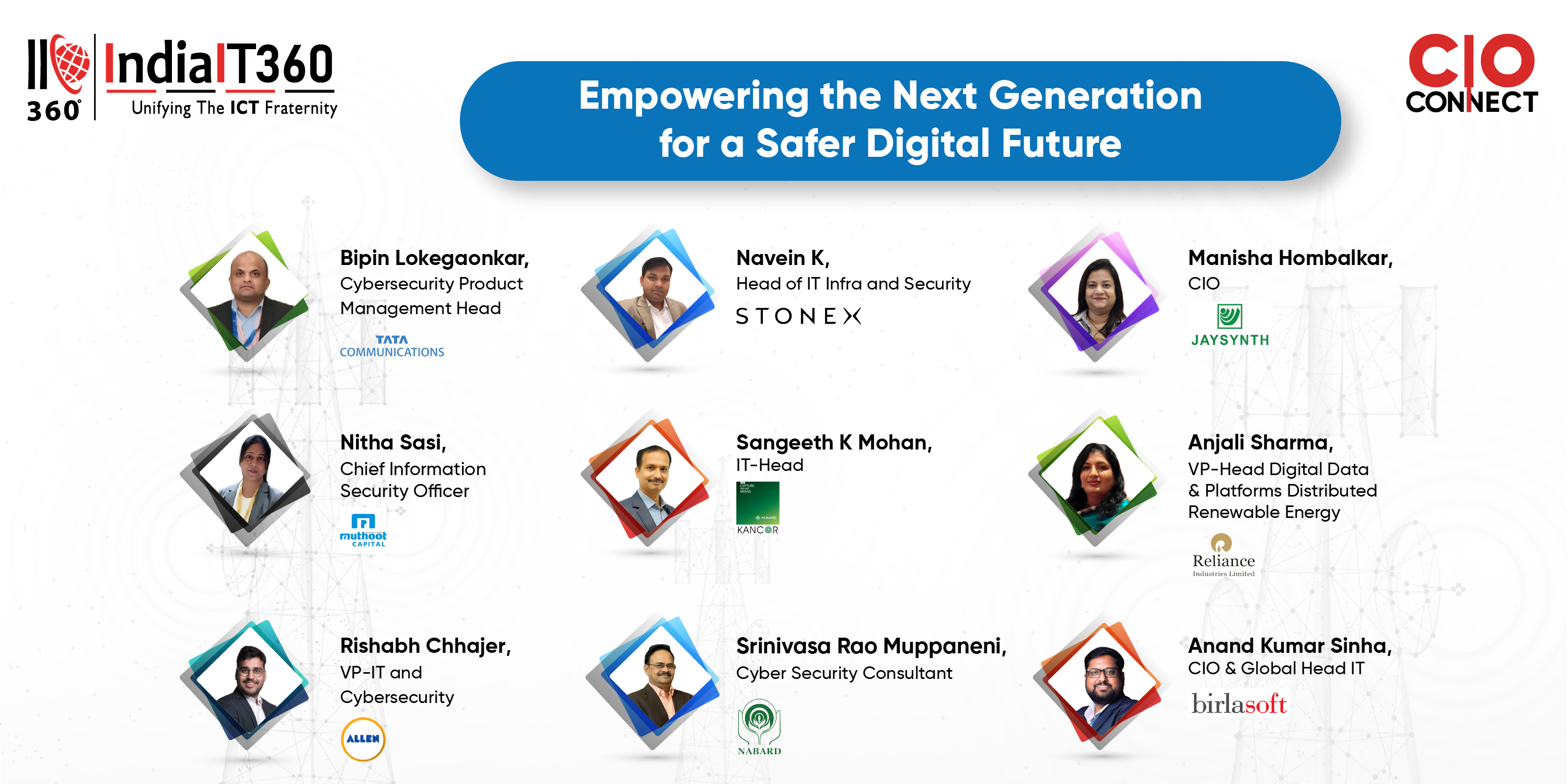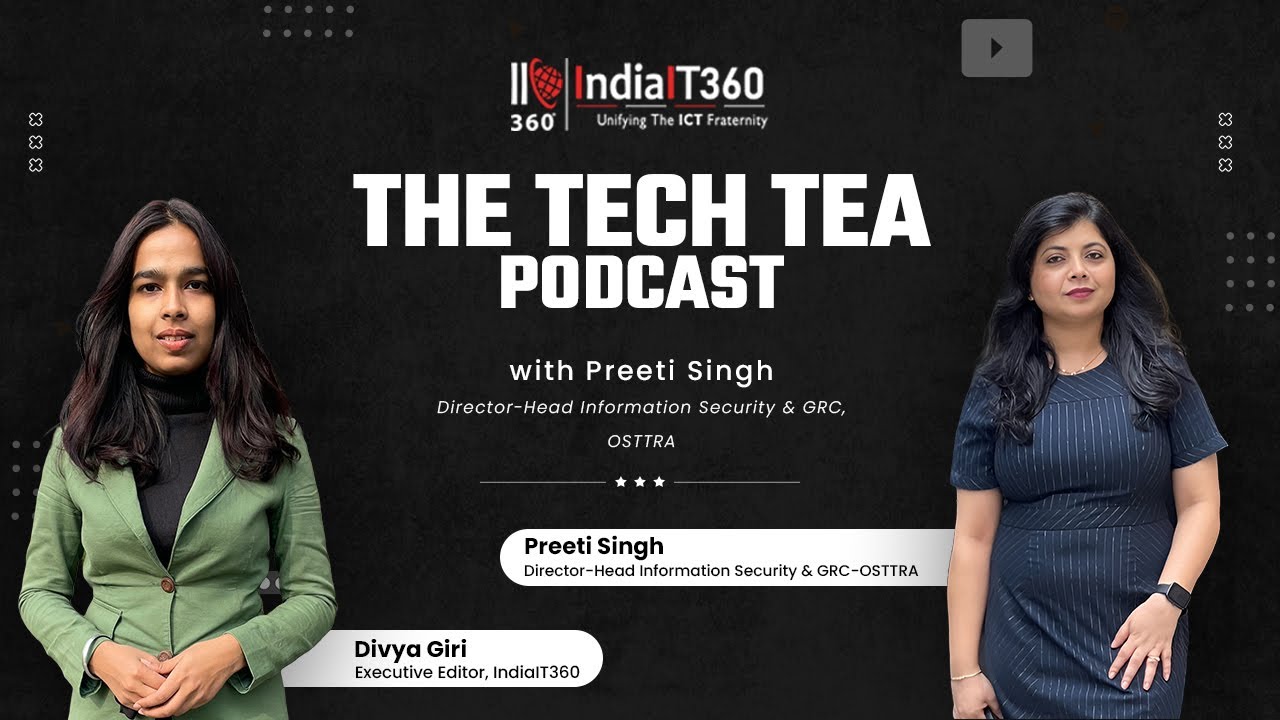Empowering the Next Generation for a Safer Digital Future
In today's well-connected era, technology plays an integral part in our daily lives. From social media interactions to online learning, children and elders are regularly exposed to digital risks like cyberbullying, phishing scams, and data privacy breaches.
So, on this Safer Internet Day, we asked a few questions to IT CxOs, and let's see their response on this.
 Nitha Sasi - Chief Information Security Officer - Muthoot Capital Services Ltd
Nitha Sasi - Chief Information Security Officer - Muthoot Capital Services Ltd
How can we ensure that Gen Beta grows up with a strong understanding of digital privacy and security, given that their lives will be intertwined with technology from birth?
Teaching Cybersecurity from an Early Age
In Schools,Cybersecurity should be as fundamental as math and science in school curriculums. Interactive platforms like Google’s “Be Internet Awesome”, CyberSmart, and Code.org can teach children how to recognize scams, create strong passwords, and protect their personal information. Schools should also conduct real-life cyber safety drills, such as phishing simulations, to help students understand online threats.
At Home, Parents play a key role in shaping children’s digital habits. Simple steps include:
- Talking About Online Safety: Explain why personal details like names, addresses, and school names should never be shared publicly.
- Creating Strong Passwords: Teach kids to use passwords like “secret codes” that only they should know.
- Encouraging a "Think Before You Click" Habit: Help them identify fake messages, suspicious links, and online scams.
 Navein Kumar Gothwal - Head of IT Infra & Security - Stonex India
Navein Kumar Gothwal - Head of IT Infra & Security - Stonex India
What tools and technologies are available to help protect younger generations from exposure to harmful content or cyberbullying online?
To protect younger generations from harmful content and cyberbullying, several tools and technologies can help:
- Parental Control Software: Apps like Qustodio, Norton Family, and Bark allow parents to monitor activity, set limits, and block inappropriate content.
- AI-Driven Content Filters: YouTube Kids, Google SafeSearch, and Microsoft Family Safety help filter out harmful material.
- Cyberbullying Detection: Tools like Covenant Eyes and SafetyWeb monitor for signs of cyberbullying and other risks.
- Secure Communication Platforms: Apps like Messenger Kids and Gabb Phone offer safe messaging and limited online access for kids.
- Educational Resources: Programs like Common Sense Media, NetSmartz, and Google’s Be Internet Awesome teach kids online safety and digital citizenship.
- Social Media Monitoring: Instagram and Facebook offer parental controls to monitor and limit interactions.
- Secure Browsers: KidZui and KidSafe provide child-friendly browsing experiences, blocking dangerous content.
Combining these tools with ongoing communication helps ensure kids’ safety in the digital world.
 Anand Kumar Sinha, CIO & Global Head IT at Birlasoft
Anand Kumar Sinha, CIO & Global Head IT at Birlasoft
How can social media platforms and online services create safer environments for Gen Z and Gen Alpha, ensuring they are shielded from identity theft, online predators, and harmful influences?
Creating Safer Digital Spaces for Gen Z and Gen Alpha.
In today's hyper-connected world, ensuring the safety of Gen Z and Gen Alpha on social media and online platforms is more critical than ever. As digital natives, they face threats such as identity theft, cyber predators, and exposure to harmful content. To mitigate these risks, we must adopt a multi-layered approach that combines technology, education, and responsible platform governance. Platforms must enforce robust privacy controls, including parental oversight and strict default settings. Secure authentication methods, such as multi-factor authentication and biometrics, enhance security. AI-driven moderation can detect and remove cyber threats, hate speech, and inappropriate content in real-time.
Education plays a key role—digital literacy programs empower young users and parents with online safety awareness. Parental control tools should allow content filtering and website blocking, while strict age verification ensures age-appropriate experiences.
By integrating advanced security, AI moderation, and educational initiatives, we can create a safer digital environment. A proactive and collaborative approach will help younger generations explore and engage online securely, fostering a more positive and protected digital space for all.
 Bipin Lokegaonkar, Head of Cloud IT & OT security at Tata
Bipin Lokegaonkar, Head of Cloud IT & OT security at Tata
How can social media platforms and online services create safer environments for Gen Z and Gen Alpha, ensuring they are shielded from identity theft, online predators, and harmful influences?
Social media channels have a chance to improve safety protocols for Gen Z and Gen Alpha by integrating stronger age check measures, implementing AI algorithms to oversee content moderation, and using improved privacy settings. Cyberbullying, identity theft, and harmful content policies should be stronger to create a more adequate environment online. Platforms should integrate parental controls and live monitoring to notice threats early on.
A safer internet is not just about implementing security measures; it’s about cultivating awareness, responsibility, and resilience among young digital users. By integrating digital literacy into education, engaging parents, and encouraging ethical online practices, we can create a culture of responsible digital citizenship. Schools, technology providers, and policymakers must work together to ensure that the next generation is equipped to tackle digital challenges with confidence. As we move forward, let Safer Internet Day serve as a reminder that a secure digital future begins with education, awareness, and collective responsibility. Only through these efforts can we empower young individuals to navigate the digital landscape safely and responsibly.
 Srinivasa Rao Muppaneni, Cyber Security Consultant - NABARD - National Bank for Agriculture and Rural Development
Srinivasa Rao Muppaneni, Cyber Security Consultant - NABARD - National Bank for Agriculture and Rural Development
What role do you believe digital literacy plays in protecting the younger generations from online risks, and how can it be incorporated into their education?
Digital literacy plays a crucial role in protecting younger generations from online risks. As children and teenagers increasingly navigate the digital world, it’s vital for them to understand how to stay safe, make informed decisions, and critically evaluate the content they encounter. By teaching digital literacy, we equip them with the skills to identify scams, protect their personal data, and recognize harmful behavior such as cyberbullying or misinformation.
To incorporate digital literacy into education, schools can take several steps:
- Curriculum Integration: Introduce digital literacy as part of the standard curriculum, not only as a separate subject but woven into lessons across subjects. Students should be taught about online privacy, security practices, and the ethical use of technology.
- Critical Thinking and Media Literacy: Encourage critical thinking by teaching students how to assess online sources for credibility, identify fake news, and differentiate between fact and opinion.
- Hands-on Training: Create opportunities for students to practice safe online behaviors through interactive lessons or role-playing scenarios that involve identifying potential online risks.
- Parent and Teacher Collaboration: Educate not only students but also teachers and parents about online safety, so they can guide children in their online activities and understand the challenges their children might face.
- Real-World Simulations: Use simulations of online risks (like phishing or cyberbullying) to help students experience and learn how to handle these situations in a controlled, supportive environment.
 Anjali Sharma, Vice President - Head Digital Data and Platforms Distributed Renewable Energy - Reliance Industries Limited
Anjali Sharma, Vice President - Head Digital Data and Platforms Distributed Renewable Energy - Reliance Industries Limited
What role do you believe digital literacy plays in protecting the younger generations from online risks, and how can it be incorporated into their education?
The education system has made great strides in incorporating essential life skills into the curriculum, such as "good touch, bad touch" awareness. While this took time to become a standard practice, we now have the opportunity to proactively integrate digital literacy into education without delay.
In today’s world, teaching children how to navigate the digital space safely is just as important as teaching them how to code. Digital literacy empowers them to recognize risks, protect their personal information, and make responsible choices online. More importantly, if they ever encounter challenges, they should feel confident reaching out to school counselors and teachers, knowing they will receive qualified, empathetic, and confidential support.
Ensuring mental well-being is just as critical as cyber safety. If a child faces cyberbullying, online fraud, or any digital threat, they should have access to a strong support system that prioritizes their emotional and psychological health.
A comprehensive digital literacy program should cover:
- Cybersecurity fundamentals to help students recognize threats like phishing and online scams.
- Ethical hacking and responsible digital behavior to create awareness about online safety.
- Understanding cyberbullying, digital footprint, and social media ethics to promote responsible engagement.
- Awareness of applicable laws and digital rights to help students understand legal protections and consequences.
- Collaboration with cybersecurity experts to provide real-world insights and hands-on learning experiences.
- Parental awareness programs to equip families with tools to support their children’s online safety.
- Understanding child psychology to ensure a holistic approach in addressing digital challenges.
- By integrating these aspects into the education system, we can empower children with knowledge, resilience, and confidence to navigate the digital world safely while fostering a culture of responsible digital citizenship.
 Rishabh Chhajer, Vice President - IT & Cybersecurity - ALLEN
Rishabh Chhajer, Vice President - IT & Cybersecurity - ALLEN
What role do you believe digital literacy plays in protecting the younger generations from online risks, and how can it be incorporated into their education?
The role of digital literacy in protecting younger generations from online risks : In today’s digital world, digital literacy is as essential as traditional education. Teaching children how to recognize misinformation, safeguard personal data, and navigate online interactions responsibly can empower them against cyber threats. Schools should integrate cyber hygiene, privacy awareness, and critical thinking into curriculum from an early age. Additionally, parents, educators, and tech companies must collaborate to provide age-appropriate guidance and tools that promote safe, ethical, and informed digital engagement.
 Manisha Hombalkar, Chief Information Officer - Jaysynth Group
Manisha Hombalkar, Chief Information Officer - Jaysynth Group
What role do you believe digital literacy plays in protecting the younger generations from online risks, and how can it be incorporated into their education?
The Importance of Digital Literacy in Protecting the Younger Generation : In today’s digital world, online safety is more important than ever. The younger generation faces risks such as misinformation, cyberbullying, phishing, and online predators. Too often, young individuals unknowingly accept friend requests from strangers and share sensitive information without realizing the consequences.
To safeguard them, we must raise awareness and equip them with the knowledge and skills needed to navigate the digital world safely and responsibly. Digital literacy helps them recognize potential threats while fostering critical thinking and ethical online behavior. It educates them about privacy risks, cyber scams, and harmful content, enabling them to distinguish between reliable and misleading information. It also encourages responsible online engagement, introduces essential Cyber security practices like password security and two-factor authentication, and empowers them to seek help when faced with online dangers.
Incorporating digital literacy into education is key. Interactive workshops, cyber threat simulations, and engaging learning experiences can enhance understanding. Training educators and parents ensures they can guide children effectively. Encouraging open discussions about online experiences fosters awareness and proactive problem-solving. Schools can also introduce dedicated courses on cyber safety, media literacy, and responsible technology use.
By making digital literacy a core part of education, we can empower younger generations to become informed, responsible, and safe digital citizens.
 Sangeeth K Mohan, Head IT - Mane (India & Sri Lanka)
Sangeeth K Mohan, Head IT - Mane (India & Sri Lanka)
What role do you believe digital literacy plays in protecting the younger generations from online risks, and how can it be incorporated into their education?
Digital literacy protects younger generations from online risks by equipping them with the knowledge, skills, and critical thinking necessary to navigate the digital world safely and responsibly. It helps young people recognize potential dangers such as cyberbullying, phishing, scams, misinformation, and inappropriate content. It fosters the ability to evaluate the credibility of online sources, distinguish between fact and fiction, and avoid falling prey to misinformation or manipulation. It also empowers young people to use technology creatively and productively while minimizing risks, enabling them to harness the benefits of the digital world.
Schools can integrate digital literacy into subjects like computer science, social studies, and even language arts. Topics could include online safety, digital citizenship, and media literacy. Hands-on workshops and simulations can teach students how to identify scams, protect their privacy, and respond to cyberbullying. Educating parents about digital risks and best practices ensures they can guide and support their children’s online activities. Schools should establish clear policies on internet use and provide guidelines for students, teachers, and parents to follow.
By embedding digital literacy into education, we can empower younger generations to navigate the digital landscape confidently, responsibly, and safely.






































